About the Call Handling Research
SQM Group has been measuring, benchmarking, tracking, and helping leading North American call center's improve First Call Resolution (FCR) and Customer Experience (CX) for over 25 years. In this blog, we share our Agent Call Handling Impact on FCR and Call Resolution research findings.
We evaluated call handling impact on the FCR rate and CX with over 500 leading North American call centers annually using a Voice of the Customer (VoC) measuring and benchmarking approach. Our Agent call handling findings are based on conducting telephone FCR post-contact transactional surveys using SQM's in-house telephone survey Agents. They called customers within one business day of their call to a call center.

Call Handling
Figure 1 shows the average call center's call handling practices from a customer point of view. SQM's customer survey data shows that 19% of all calls are transferred to another Agent, the call needed assistance from another Agent 20% of the time, and customers were put on hold 46% of the time. In addition, the average handle time (AHT) call length (talk and wrap up) is approximately seven minutes, and 9% of the calls are pending, which means a fulfillment employee needs to provide additional information to complete the interaction.
Figure 1: Call Handling Practices from a VoC Point of View
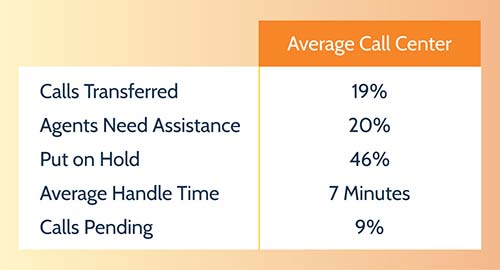
Transfer of Calls
Figure 2 shows that when a customer is transferred, FCR is 14% lower, and call resolution is 4% lower than when a customer is not transferred. This is because calls that are transferred to another Agent tend to be more complex calls and, as a result, have lower call resolution. It is important to note that SQM's research shows that 19% of customers who call a call center are transferred to another Agent. The main reason why customers are transferred to another Agent is that the IVR voice menu system did not route the customer to the right Agent in the first place, or Agent knowledge, skills, and abilities are poor.
Figure 2: Transfer of Calls Impact on FCR and Call Resolution
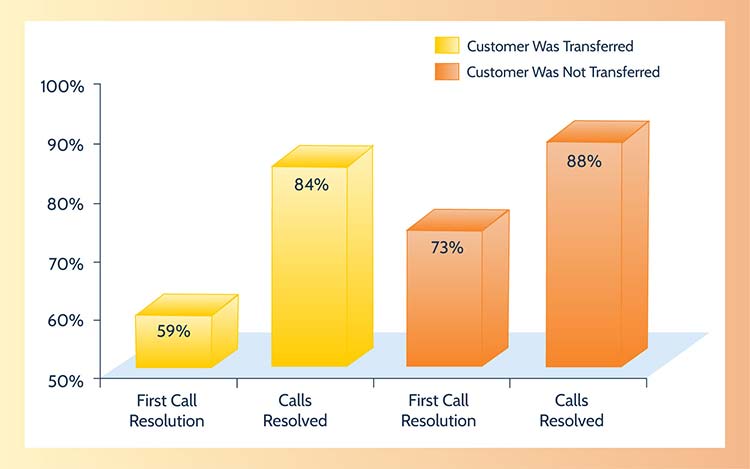
Agent Assisted Calls
Figure 3 shows that when an Agent needs assistance to resolve a customer's call, the Agent assisted call has 16% lower FCR and 7% lower call resolution performance. In addition, customer service Agents need assistance from another Agent, supervisor, or helpdesk Agent to help resolve the customer's inquiry or problem on 20% of the calls they handled.
SQM's employee satisfaction research shows that Agents are very dissatisfied with the real-time support they receive during a call. As a result, the call center industry needs to become better at providing real-time support for Agents.
To improve real-time Agent support, call centers need to have more knowledgeable support employees and have support employees available in real-time to help Agents resolve the customer's call when they need assistance. Good support employees (e.g., escalation Agents, helpdesk Agents) to customer service Agents ratio is 15 to 1.
Figure 3: Agent Assisted Calls Impact on FCR and Call Resolution
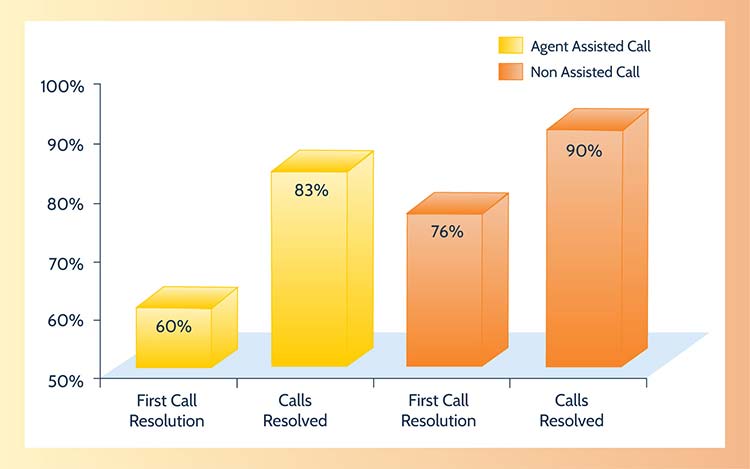
Put on Hold
Figure 4 shows that when customers are put on hold, FCR is 19% lower, and call resolution is 10% lower than when customers are not put on hold. SQM's research shows that 46% of all customers who call a call center are put on hold.
Most customers are informed that they are being put on hold. The hold time is typically between 30 seconds and 5 minutes. In many cases, when customers are put on hold, there is music or advertising in the background, both of which can create customer dissatisfaction.
Customers prefer a live hold practice, meaning that they can talk to the Agent at any time during the call, versus a mute hold practice that does not allow them to talk to the Agent. Another critical finding around the live hold practice is that AHT is shorter with a live hold versus a mute hold. The shorter AHT is because the Agent has a greater sense of urgency to resolve the call when the live hold business practice is used.
Figure 4: Put on Hold Impact on FCR and Call Resolution
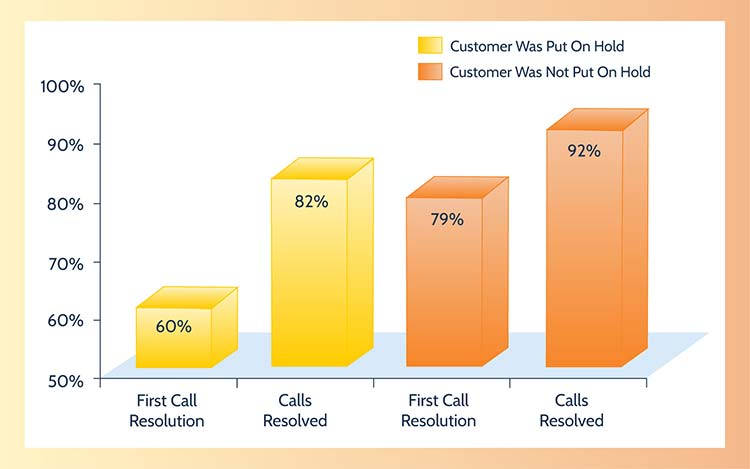
AHT Call Length Impact on FCR
Figure 5 shows that FCR is significantly lower the longer the AHT call length. For example, when the call length is 1 to 3 minutes, FCR is 73%, 3 to 5 minutes, FCR is 71%, 5 to 9 minutes, FCR is 69%, 10 to 15 minutes, FCR is 67%, and more than 15 minutes, FCR is 62%.
One of the most helpful business practices for lowering call length is to reduce call complexity. Many SQM clients streamline their business practices through software applications to make it easier for the Agent to resolve customer calls. Since call centers are handling more complex calls, streamlining processes and software practices is a worthy initiative.
SQM clients who have improved their FCR because of a new software initiative have focused on improving FCR. Call centers are so complex that they require many different software applications to support Agents handling calls to provide FCR and a great customer experience. The top three software applications that our clients have focused on for streamlining are unified desktop, customer relationship management, and knowledge management tool.
Figure 5: AHT Call Length Impact on FCR
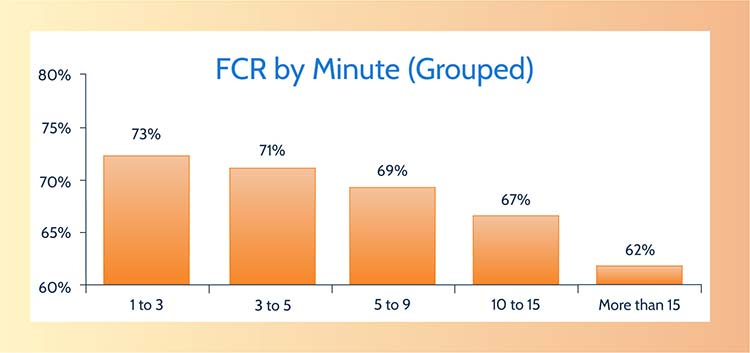
Call Wrap-up
Figure 6 shows the impact that different wrap-up practices have on FCR and call resolution performance. When calls are wrapped up while the customer is on the phone, FCR is 4% higher, and call resolution is 1% higher than when the Agent wraps up after the call. In addition, FCR is higher when the wrap-up is done while the customer is still on the phone because the Agent tells the customer what they did or are going to do to resolve their call.
Figure 6: Call Wrap-up Impact on FCR and Call Resolution
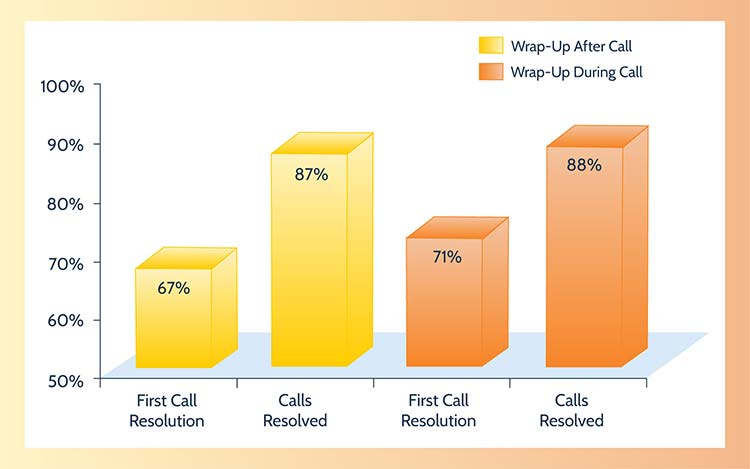
Pended Calls
Figure 7 shows that FCR and call resolution are 12% lower when a customer's call is pended. When Agents need to conduct research or have someone in the organization do some research on a customer inquiry or problem, the call is pended. A 'pended call' means the call is unresolved (open) until the research on the customer's inquiry or problem is completed (closed). SQM's research shows on average, 9% of calls are pended.
Call centers that have more than 5% of their calls pended represent an opportunity for improvement. SQM's research shows that call centers with a high number of pended calls (10% or higher) also have low FCR performance. Lowering the number of pended calls can significantly improve FCR performance. A high number of pended calls is a leading indicator of poor FCR performance.
Figure 7: Pended Calls Impact on FCR and Call Resolution
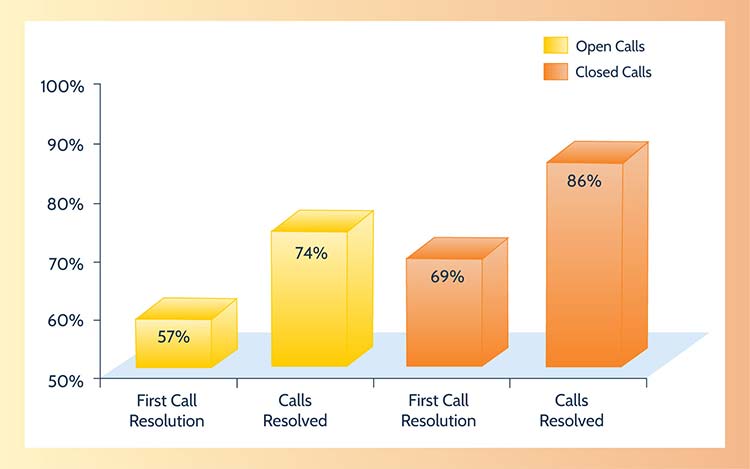
Ranking of the Most Helpful Business Practices for Improving FCR
SQM agrees that any of the business practices in Figure 8 can improve FCR and CX performance. According to our clients, the top five business practices for improving FCR are:
- Management focuses on improving FCR
- Post-call customer surveying
- Focused FCR training (new hire & ongoing)
- Streamlining business practices
- Incorporating call resolution/Csat into a QA program
Figure 8: Ranking of the Most Helpful Business Practices for Improving FCR
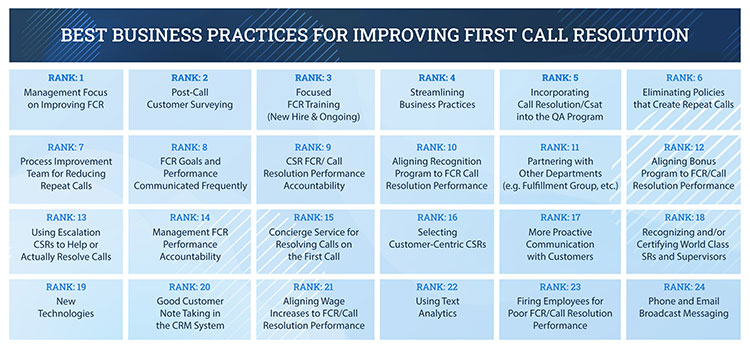
Quick Related Links
First Call Resolution Definition First Call Resolution PPT First Call Resolution Benefits
First Call Resolution Strategies First Call Resolution Operating Philosophy FCR Case Study Survey Data Calculate First Call Resolution Rate VoC Closed-Loop Top 10 CX Metrics Outside-In or Inside-Out Journey Mapping
